
左 脇差Sa Wakizashi
No.678311額銘 左 行吉 大左一門 富山2604号大名登録 金筋掛り地刃明るく冴える名品 一尺六寸一分Gakumei Sa Yukiyoshi Osa Ischion Toyama No.2604 Registered Daimyo Konjikake Kinsuji-kakari Jiba is bright and clear A masterpiece 48.9cm
ご成約Sold
- 銘表Mei-Omote
- 行吉行吉 Yukiyoshi
- 登録証Registration
- 富山県 Toyama 昭和29年7月18日 7/18/29(Showa)
- 時代Period
- 南北朝時代Nanbokucho era
- 法量Size
-
刃長 48.9cm (一尺六寸一分) 反り 0.6cm
元幅 2.8cm 先幅 0.0cm 元重 0.41cm 鎬厚 0.75cm 先重 0.00cm 鋒長 0.0cm 茎長 14.0cm 重量 485gHachou 48.9cm (一尺六寸一分) Sori 0.6cm
Moto-Haba 2.8cm Saki-Haba 0.0cm Moto-Kasane 0.41cm Shinogi-Thikess 0.75cm Saki-Kasane 0.00cm Kissaki-Chou 0.0cm Nakago-Chou 14.0cm Weight 485g - 国Country
- 筑前Chikuzen
- 姿Shape
- 長巻直し造、庵棟、身幅尋常、反りやや浅くつくNagamaki-naoshi-tsukuri, Iorimune, Standard Mihaba, Slightly shallow Sori.
- 鍛Kitae
- 板目肌に、杢目交じり、地沸微塵に厚くつき、地景よく入り、映り立つ。Itamehada, Mixed Mokume, Jinie entered fine and thick, Chikei entered often, Utsuri-tatsu.
- 刃文Hamon
- 直刃調に、小互の目交じり、ほつれ・湯走り・二十刃掛り、足・葉よく入り、小沸深くよくつき、金筋・沸筋・砂流し頻りにかかり、匂口明るく冴える。Suguha-style, Mixed Small-Gunome, Hotsure, Yubashiri, Nijuba-kakari, Tere are many Ashi and You, Small-Nie entered deep and well, Kinsuji, Niesuji and Sunagashi-shikirini-kakaru. Nioikuchi is bright and clear.
- 帽子Boushi
- のたれ込んで焼きつめる。Notarekonde-yakitsumeru
- 茎Nakago
- 磨上、先栗尻、鑢目勝手下り、目釘孔一。Suriage, Sakikurijiri, Yasurimekattesagari, Mekugiana is 1.
- ハバキHabaki
- 銅一重。Single copper.
- 説明Drscription
- 筑前国左文字は、大左と通称され、実阿の子と伝え、銘文の左は、左衛門三郎の略という。相州正宗十哲の一人に数えられ、それまでの古典的な九州物の作域から大いに脱皮し、地刃共に明るく冴え、地景や金筋の目立つ新作風を確立した。現存する在銘の太刀は、国宝の「江雪左文字」のみであるが、短刀の作例は比較的多く残されている。左一門は、南北朝期に大いに栄えたが、大左の子と伝える貞吉・安吉を始め弘行・国弘などがいて、これら左一門を末左と呼称する。行吉は、弘行の子で、南北朝後期に活躍している。この刀は、行吉在銘の長巻直しで、額銘ながら銘は明瞭に残されている。身幅尋常、鎬の高い菖蒲造の姿で、板目肌に、杢目肌交じり、地沸が微塵に厚くつき、地景がよく入り、肌だちごころに、やや黒みを帯びた地鉄に、直刃調に、小互の目交じり、足・葉よく入り、小沸深くよくつき、金筋・沸筋・砂流し頻りにかかる、刃中よく働き、地刃明るく冴える在銘の名品である。Chikuzen Province Samonji is commonly called Osa, and is said to be the child of Jitsua, and the left of the inscription is said to be an abbreviation for Saemon Saburo.
Counted as one of the Soshu Masamune Jittetsu, he has largely broken away from the classical Kyushu production area, and Jiba is bright and clear, establishing a new style that stands out from Chikei and Kinsuji.
The only extant tachi with an inscription is the national treasure 'Kosetsu Samonji', but there are relatively many examples of Tanto.The Sa clan prospered greatly during the Nanbokucho period, and included Sadayoshi and Yasukichi, who are said to be the children of Osa, Hiroyuki, Kunihiro, and others, and these left clan is called Suesa.
Yukiyoshi is the son of Hiroyuki and is active in the late Nanbokucho period.This sword is Nagamakinaoshi with Yukiyoshi signature.
The inscription is clearly left even though it is a forehead.
Standard Mihaba, High Shinogi Syoubu-dukuri style, Itamehada, Mixed Mokume-hada, Jinie entered fine and thick, Chikei entered well, Hadadahi-gokoro, On a slightly darker Jigane, Suguha-style, Mixed small-Gnome, There are many Ashi and You, Small-Nie entered well, Kinsuji, Niesuji, Sunagashi-shikirinikakaru.
It is a masterpiece with a signature that works well in the swords Jiba is bright and clear.


